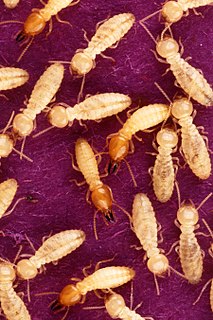
Termites are eusocial insects that are classified at the taxonomic rank of infraorder Isoptera, or as epifamily Termitoidae within the order Blattodea. Termites were once classified in a separate order from cockroaches, but recent phylogenetic studies indicate that they evolved from cockroaches, as they are the sister group to wood eating cockroaches of the genus Cryptocercus. Previous estimates suggested the divergence took place during the Jurassic or Triassic. More recent estimates suggest they have an origin during the Late Jurassic, with the first fossil records in the Early Cretaceous. About 3,106 species are currently described, with a few hundred more left to be described. Although these insects are often called "white ants", they are not ants, and are not closely related to ants.

Dictyoptera is an insect superorder that includes two extant orders of polyneopterous insects: the order Blattodea and the order Mantodea (mantises). While all modern Dictyoptera have short ovipositors, the oldest fossils of Dictyoptera have long ovipositors, much like members of the Orthoptera.

Ectobiidae is a family of the order Blattodea (cockroaches). This family contains many of the smaller common household pest cockroaches, among others. They are sometimes called wood cockroaches. A few notable species include:
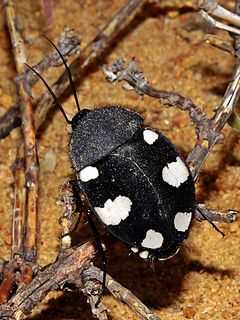
Blattodea is an order of insects that contains cockroaches and termites. Formerly, the termites were considered a separate order, Isoptera, but genetic and molecular evidence suggests an intimate relationship with the cockroaches, both cockroaches and termites having evolved from a common ancestor. The Blattodea and the mantises are now all considered part of the superorder Dictyoptera. Blattodea includes approximately 4,400 species of cockroach in almost 500 genera, and about 3,000 species of termite in around 300 genera.

Cockroaches are insects of the order Blattodea, which also includes termites. About 30 cockroach species out of 4,600 are associated with human habitats. Some species are well-known as pests.

Supella is a genus of cosmopolitan and wild cockroaches, in the family Ectobiidae: originating from Africa and the Arabian Peninsula.
Archimylacris is an extinct genus of cockroach-like blattopterans, a group of insects ancestral to cockroaches, mantids, and termites.
Blattabacterium is a genus of obligate mutualistic endosymbiont bacteria that are believed to inhabit all species of cockroach studied to date, with the exception of the genus Nocticola. The genus' presence in the termite Mastotermes darwiniensis led to speculation, later confirmed, that termites and cockroaches are evolutionarily linked.
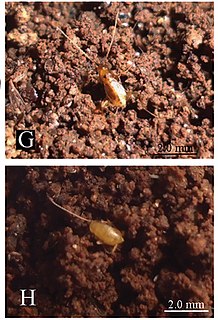
Nocticola is a genus of cockroaches in the family Nocticolidae distributed in Africa, south-east Asia and Australia. Nocticola are different from every other cockroach in that they are not infected with Blattabacterium cuenoti. This makes them the only genus in Blattodea that do not have the bacteria.

Ectobius is a genus of non-cosmopolitan cockroaches native to Old World described by Stephens in 1835, belonging to the family Ectobiidae, subfamily Ectobiinae. This genus has been subject to a number of revisions.

Planuncus is a genus of cockroaches native to Old World described by Bohn in 2013 and belonging to the family Ectobiidae, subfamily Ectobiinae.

Planuncus tingitanus s.l. is a working title for any of the species belonging to the Planuncus tingitanus species group, of the cockroach genus Planuncus. As the exact status of some the species in this group can not be determined without more research, the whole species complex is referred to by the name of the oldest species in the group sensu lato.
Simandoa conserfariam, also known as the Simandoa cave roach, is a species of cockroach that is currently considered extinct in the wild. However, it is kept as a pet by insect hobbyists and is therefore not considered completely extinct. Its only known habitat was one cave in the Simandou region of Guinea, where it lived in guano, however they can be recognized by their unique coloring across their head and body region.
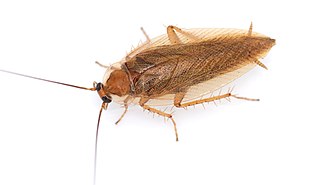
The amber wood cockroach Ectobius vittiventris belongs to the order of blattodea. It is a species of wood cockroach originally from southern Europe. It is completely harmless to humans and does not appear as a storage pest, as it only feeds on decomposing plant material and perishes within a few days in human dwellings due to a lack of food. Its original range is south of the Alps, but this species seems to have established itself permanently north of the Alps and in southern Germany.
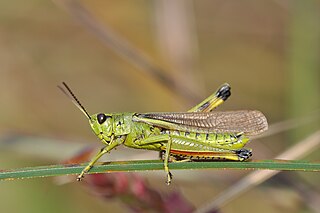
The large marsh grasshopper, Stethophyma grossum, is a species belonging to the family Acrididae subfamily Oedipodinae.

Ectobius lapponicus is a species in the order Blattodea, in the class Insecta ("insects"). A common name for Ectobius lapponicus is "dusky cockroach".

Ectobius pallidus, the tawny cockroach, is a species of non-cosmopolitan cockroach in the family Ectobiidae. It occurs in southern England, Belgium, France, the Netherlands, Germany, Switzerland, Italy, Spain and Portugal; in North Africa: Algeria and Tunisia.
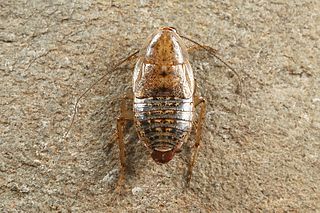
Capraiellus is a genus of non-cosmopolitan cockroaches in the family Ectobiidae.

Ectobius sylvestris, known generally as the forest cockroach or lesser cockroach, is a species of cockroach in the family Ectobiidae. It is found in Europe & Northern Asia, North America, and temperate Asia.















